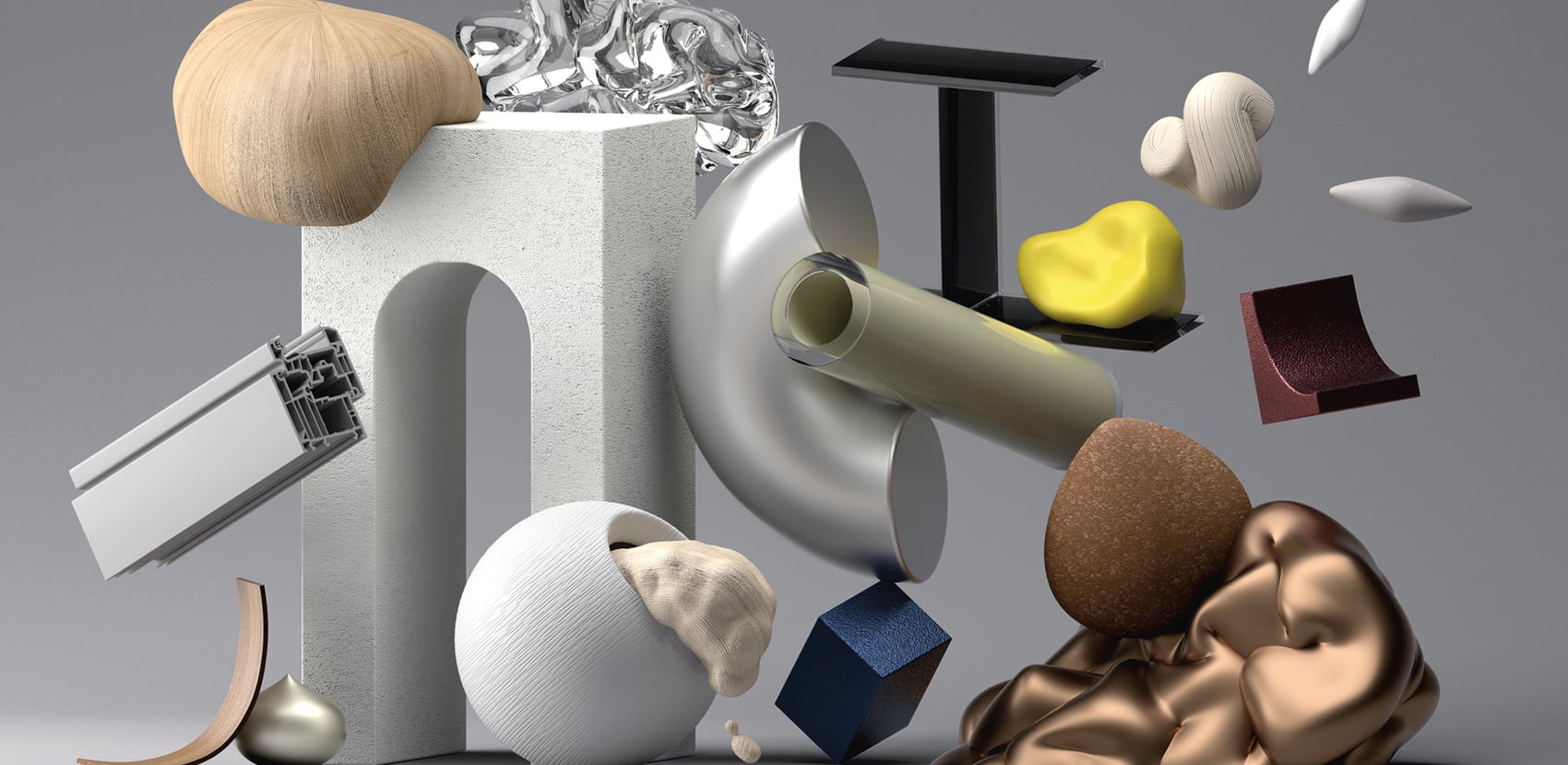
Truth and deception.
Always beautifully objective. Efrat Friedland talks about her work as a materials consultant.
Efrat Friedland worked for many years as an industrial designer, only to discover that there are enough products in the world. Today, she is pursuing a much more exciting question, the question of materials, their specific behaviour, and their impact on aesthetics and functionality. Since 2003 she has been working as a “materials consultant”, advising designers, architects and engineers in the design process. About the wrong type of wood and the right type of impact.
Interview: Hannes Schmidt
Illustration: Wang & Söderström
You work as a materials consultant – what does your work involve?
Efrat Friedland: Unlike my colleagues, who are often more technically oriented, I also advise on design and interior decoration: I thus deal with the aesthetic and emotional as well as the functional factors with the aim of doing justice to every material facet of a project. Unfortunately, teaching about materials is still grossly neglected in design colleges. Students are so overloaded with other teaching content that there is little time left for dealing with materials. That’s why I still think it’s a good idea also to train designers using a materials library.
What is a materials library, and how is it structured?
I collect materials that are already on the market or in use, as well as those that come fresh from the research laboratories or industry. These are samples, i.e. test items or examples, that come with technical and practical information. They are strictly sorted into material families such as plastic, metal, wood and so on – not according to trends. I am not in the business of researching trends. My message is: these are the materials that you can use. I have built up a large network of sources over the years that regularly supply me with samples. Of course, as a scout, I also visit technology fairs, make company visits, and read newsletters and trade magazines.
So your library is pretty technical. What advice do you give on aesthetic matters?
My clients are mainly from industry. I work with the designers in companies. Usually a product concept already exists. Or at least a target group has been defined. Or there is a story that tells how the product should be released onto the market. I try to persuade customers to use the respective material in the most natural way possible – without, for example, coating it or painting it. All so that it can show its “true face” and not hide its aesthetic qualities. We make sure that the aesthetic aspects are authentic because, after all, the product is supposed to sell itself. And if the aesthetic side is right, then the emotion triggered by the material will function.
Can beauty be “objectified” and assigned to specific materials?
There is a saying: beauty is in the eye of the beholder. So, in that sense, it is a matter of personal taste. But I would say that every material contains its own beauty within itself. But when it comes to designing a product or a space, different materials come together. This requires a designer who can select and direct – because the aesthetics will then be determined by the overall picture. And getting the taste right is a hard question to answer; perhaps even more difficult in architecture than in design, especially in public spaces, where the aesthetics must be geared to many different tastes. The most important question is then, of course, the target audience. And the biggest mistake that a designer or architect can make is to choose a design that pleases him or her personally the most. At any rate, this cannot be due to a lack of choice in materials: today we are in the happy position that the market is saturated, even oversaturated. There are always several suitable alternatives for every product or project.
The world of materials is often divided into “real” and “fake”. Is a material that can perfectly imitate another then less authentic than its original?
I would say that most people prefer real materials to imitations. However, some imitations act smarter than the original when it comes to specific applications. In such cases, beauty offers more through intelligence than aesthetics. For example, the Bader Leather company uses leather offcuts mixed with mostly bio-based polymers in its injection moulding processes. You can feel the warmth of the leather when you touch a cup or a tray. The cup even smells of it! The products contain a high proportion of leather fibres, but you cannot of course see any of the seams that usually result from leather processing. Because it is purely injection moulded. After the first “wow” effect, we might wonder whether we like it or not, whether it is attractive or not – but, no matter what you might think of this material and technology, you cannot avoid taking a view on it: This is a pretty smart product that I’m holding in my hand...
Is there such a thing as a good or a bad material?
No, there isn’t. Just as there is no sustainable or non-sustainable material. It is simply a question of the use and the handling of the material – how it is applied. For example, an architect might decide to construct a “green building” using only natural materials. So he chooses bamboo for the design of the entrance because it is so sustainable. Let’s ignore the fact that bamboo is grown in monocultures in Japan and then shipped to another continent... the bamboo should then be preserved, as an entrance like that should last for years. So the wood is covered with a resin layer. Stepping through the entrance, you can still see the bamboo, you admire the beauty of nature – but there is now no way of separating the wood and the resin so as to recycle them. Bamboo is a plant that grows fast, needs hardly any water and is abundant. Yet it is treated in a way that turns it into a radically non-sustainable material.
Interview: Hannes Schmidt
Illustration: Wang & Söderström
You work as a materials consultant – what does your work involve?
Efrat Friedland: Unlike my colleagues, who are often more technically oriented, I also advise on design and interior decoration: I thus deal with the aesthetic and emotional as well as the functional factors with the aim of doing justice to every material facet of a project. Unfortunately, teaching about materials is still grossly neglected in design colleges. Students are so overloaded with other teaching content that there is little time left for dealing with materials. That’s why I still think it’s a good idea also to train designers using a materials library.
What is a materials library, and how is it structured?
I collect materials that are already on the market or in use, as well as those that come fresh from the research laboratories or industry. These are samples, i.e. test items or examples, that come with technical and practical information. They are strictly sorted into material families such as plastic, metal, wood and so on – not according to trends. I am not in the business of researching trends. My message is: these are the materials that you can use. I have built up a large network of sources over the years that regularly supply me with samples. Of course, as a scout, I also visit technology fairs, make company visits, and read newsletters and trade magazines.
So your library is pretty technical. What advice do you give on aesthetic matters?
My clients are mainly from industry. I work with the designers in companies. Usually a product concept already exists. Or at least a target group has been defined. Or there is a story that tells how the product should be released onto the market. I try to persuade customers to use the respective material in the most natural way possible – without, for example, coating it or painting it. All so that it can show its “true face” and not hide its aesthetic qualities. We make sure that the aesthetic aspects are authentic because, after all, the product is supposed to sell itself. And if the aesthetic side is right, then the emotion triggered by the material will function.
Can beauty be “objectified” and assigned to specific materials?
There is a saying: beauty is in the eye of the beholder. So, in that sense, it is a matter of personal taste. But I would say that every material contains its own beauty within itself. But when it comes to designing a product or a space, different materials come together. This requires a designer who can select and direct – because the aesthetics will then be determined by the overall picture. And getting the taste right is a hard question to answer; perhaps even more difficult in architecture than in design, especially in public spaces, where the aesthetics must be geared to many different tastes. The most important question is then, of course, the target audience. And the biggest mistake that a designer or architect can make is to choose a design that pleases him or her personally the most. At any rate, this cannot be due to a lack of choice in materials: today we are in the happy position that the market is saturated, even oversaturated. There are always several suitable alternatives for every product or project.
The world of materials is often divided into “real” and “fake”. Is a material that can perfectly imitate another then less authentic than its original?
I would say that most people prefer real materials to imitations. However, some imitations act smarter than the original when it comes to specific applications. In such cases, beauty offers more through intelligence than aesthetics. For example, the Bader Leather company uses leather offcuts mixed with mostly bio-based polymers in its injection moulding processes. You can feel the warmth of the leather when you touch a cup or a tray. The cup even smells of it! The products contain a high proportion of leather fibres, but you cannot of course see any of the seams that usually result from leather processing. Because it is purely injection moulded. After the first “wow” effect, we might wonder whether we like it or not, whether it is attractive or not – but, no matter what you might think of this material and technology, you cannot avoid taking a view on it: This is a pretty smart product that I’m holding in my hand...
Is there such a thing as a good or a bad material?
No, there isn’t. Just as there is no sustainable or non-sustainable material. It is simply a question of the use and the handling of the material – how it is applied. For example, an architect might decide to construct a “green building” using only natural materials. So he chooses bamboo for the design of the entrance because it is so sustainable. Let’s ignore the fact that bamboo is grown in monocultures in Japan and then shipped to another continent... the bamboo should then be preserved, as an entrance like that should last for years. So the wood is covered with a resin layer. Stepping through the entrance, you can still see the bamboo, you admire the beauty of nature – but there is now no way of separating the wood and the resin so as to recycle them. Bamboo is a plant that grows fast, needs hardly any water and is abundant. Yet it is treated in a way that turns it into a radically non-sustainable material.

To what extent will the materiality of an object – whether in design or in architecture – determine its aesthetic quality and charisma?
The materiality of an object has a clear effect on its aesthetic value. But this depends critically on the functionality and purpose of this object. With an object consisting of just one material – whether a sculpture or a chair – the attention is far more focused on the selected material than in the case of objects composed of multiple materials. The shape also plays an important role. Take for example the famous Panton Chair, which is of course made entirely of plastic. It follows a very specific aesthetic concept: it communicates fun, a certain amount of informality, it appears light in weight and simply looks comfortable. If we were to make the same model in polished stainless steel, I would imagine that nothing like as many people would want to sit on it. If we opted for stone, the chair would instead assume the character of a sculpture – scarcely mobile, rather cold and not especially inviting. In the case of objects or spaces that are composed of several materials, the key to their aesthetic effect lies in my opinion in the relationship between the materials and the colour or the choice of pattern. You can work with the highest quality materials, but even the smallest error in their application or percentage distribution can lead to undesirable end results. In addition, everything has of course to function in daily use.
Natural versus synthetic materials – which is the better choice?
They are not in fact in competition with each other. Both types of material have a right to exist. Wood, for example: when I opened my materials library in Israel, it was fashionable to imitate wood. So I opted for a laminated flooring with a wood look – Burnt Oak, made in China – that looked deceptively real, even in terms of grain. Many architects visited, and almost all of them thought my floor was genuine oak. For many people, plastic is a turn-off. But when you think about it, using real wood for an area of 200 square metres should also involve thinking about cutting down forests and the energy required in manufacturing. Sure, we got the laminate from China, but we still used a lot less energy overall for the flooring. It is never simply a question of either-or. If there is a good reason to use uPVC, then there is nothing wrong with doing that. Everything always depends on the context.
Classic polymer materials, i.e. plastics, are 100 percent composed of crude oil. What happens when the source runs dry?
One alternative is to recycle these materials. Virgin polymers, in other words new material, can be ground up after their first use and reused up to seven times without any loss of quality. Another possibility is the use of additives – that is, reducing the amount of crude oil and using a greater proportion of natural additives, such as minerals, in a ratio of 70 to 30 for example. Or you can make plastic-like materials entirely from natural materials, such as corn or sugar. This works with disposable products such as bags or cups, but these are not expected to deliver top-quality performance. But now the industry is working harder to improve the quality of such material as, after all, we eventually want to replace petroleum. The new generation of “bioplastics”, for example, should even now have a minimum usable life of two to three years.
What are the materials of the future? And where do you see new trends appearing?
One of the most important megatrends, one that is persistent and spreading, is individualism. For products this means that they can be individually changed as regards their colour, material composition and even their function and adapted to the user’s own needs. That is why research is currently being conducted on the development of so-called adaptive materials. Interestingly enough, this also makes possible utilisation concepts that seem to set a limit on unlimited individualism – reacting for example to lack of space or housing shortages. This is reflected in dwellings where one household shares spaces and objects, instead of everyone keeping everything they need within their own four walls. The magic word here is “sharing”. Naturally, highly adaptive materials will also help. On the other hand, so as to simplify sharing, we may not need such intelligent and adaptable materials. This currently concerns the car industry in particular: the more that people switch to carsharing, the more cars will become a public rather than a private space. And that of course has an influence on the choice of materials.
There exist many new materials. How and why are they developed?
This may be for economic or fashion reasons: a trend calls for a new material ... Of course, there are also scientists and engineers who invent purely for the sake of it. And then, maybe, rediscover this material after two years and say: Hey, look what we have here – what could we do with it? Incidentally, this also happens in industry, not just in research. At the same time, I find it fascinating that more and more young designers are beginning to invent materials themselves. Not because there are not enough materials, but as a consequence of radically responsible, sustainability-conscious thinking. These designers will only use natural resources ... they cook, bake, grind, chew and combine them with other natural materials. In other words, these young creatives are particularly interested in the materials they use, especially regional, natural and sustainable materials. There are numerous courageous experiments being conducted in this search for a new language of materials. And that is a very, very positive development.
Are smart materials really smart?
I do not believe they exist. The official definition of these materials is that they respond to external stimuli, such as UV light or hot water. Industry considers materials smart if they can change their surface or react. I however believe that any “smartness” or “stupidity” of materials is a consequence of their use. Imagine your smartphone display is made of self-repairing glass: you drop it and the glass shatters. No problem, it reassembles itself. But this glass is incredibly expensive. Instead of 300 euros, I reckon you will pay 3,000 euros for such a phone. Is that such a smart decision given that so many people in any case now change their phone every few years? By contrast, using glass like this in a military jeep might even save people’s lives by protecting them from bullets. It is up to the designer, engineer or even the architect to determine the way a material is used and therefore its smartness. Many of the so called intelligent materials only help us on the way to becoming less intelligent ourselves.
The materiality of an object has a clear effect on its aesthetic value. But this depends critically on the functionality and purpose of this object. With an object consisting of just one material – whether a sculpture or a chair – the attention is far more focused on the selected material than in the case of objects composed of multiple materials. The shape also plays an important role. Take for example the famous Panton Chair, which is of course made entirely of plastic. It follows a very specific aesthetic concept: it communicates fun, a certain amount of informality, it appears light in weight and simply looks comfortable. If we were to make the same model in polished stainless steel, I would imagine that nothing like as many people would want to sit on it. If we opted for stone, the chair would instead assume the character of a sculpture – scarcely mobile, rather cold and not especially inviting. In the case of objects or spaces that are composed of several materials, the key to their aesthetic effect lies in my opinion in the relationship between the materials and the colour or the choice of pattern. You can work with the highest quality materials, but even the smallest error in their application or percentage distribution can lead to undesirable end results. In addition, everything has of course to function in daily use.
Natural versus synthetic materials – which is the better choice?
They are not in fact in competition with each other. Both types of material have a right to exist. Wood, for example: when I opened my materials library in Israel, it was fashionable to imitate wood. So I opted for a laminated flooring with a wood look – Burnt Oak, made in China – that looked deceptively real, even in terms of grain. Many architects visited, and almost all of them thought my floor was genuine oak. For many people, plastic is a turn-off. But when you think about it, using real wood for an area of 200 square metres should also involve thinking about cutting down forests and the energy required in manufacturing. Sure, we got the laminate from China, but we still used a lot less energy overall for the flooring. It is never simply a question of either-or. If there is a good reason to use uPVC, then there is nothing wrong with doing that. Everything always depends on the context.
Classic polymer materials, i.e. plastics, are 100 percent composed of crude oil. What happens when the source runs dry?
One alternative is to recycle these materials. Virgin polymers, in other words new material, can be ground up after their first use and reused up to seven times without any loss of quality. Another possibility is the use of additives – that is, reducing the amount of crude oil and using a greater proportion of natural additives, such as minerals, in a ratio of 70 to 30 for example. Or you can make plastic-like materials entirely from natural materials, such as corn or sugar. This works with disposable products such as bags or cups, but these are not expected to deliver top-quality performance. But now the industry is working harder to improve the quality of such material as, after all, we eventually want to replace petroleum. The new generation of “bioplastics”, for example, should even now have a minimum usable life of two to three years.
What are the materials of the future? And where do you see new trends appearing?
One of the most important megatrends, one that is persistent and spreading, is individualism. For products this means that they can be individually changed as regards their colour, material composition and even their function and adapted to the user’s own needs. That is why research is currently being conducted on the development of so-called adaptive materials. Interestingly enough, this also makes possible utilisation concepts that seem to set a limit on unlimited individualism – reacting for example to lack of space or housing shortages. This is reflected in dwellings where one household shares spaces and objects, instead of everyone keeping everything they need within their own four walls. The magic word here is “sharing”. Naturally, highly adaptive materials will also help. On the other hand, so as to simplify sharing, we may not need such intelligent and adaptable materials. This currently concerns the car industry in particular: the more that people switch to carsharing, the more cars will become a public rather than a private space. And that of course has an influence on the choice of materials.
There exist many new materials. How and why are they developed?
This may be for economic or fashion reasons: a trend calls for a new material ... Of course, there are also scientists and engineers who invent purely for the sake of it. And then, maybe, rediscover this material after two years and say: Hey, look what we have here – what could we do with it? Incidentally, this also happens in industry, not just in research. At the same time, I find it fascinating that more and more young designers are beginning to invent materials themselves. Not because there are not enough materials, but as a consequence of radically responsible, sustainability-conscious thinking. These designers will only use natural resources ... they cook, bake, grind, chew and combine them with other natural materials. In other words, these young creatives are particularly interested in the materials they use, especially regional, natural and sustainable materials. There are numerous courageous experiments being conducted in this search for a new language of materials. And that is a very, very positive development.
Are smart materials really smart?
I do not believe they exist. The official definition of these materials is that they respond to external stimuli, such as UV light or hot water. Industry considers materials smart if they can change their surface or react. I however believe that any “smartness” or “stupidity” of materials is a consequence of their use. Imagine your smartphone display is made of self-repairing glass: you drop it and the glass shatters. No problem, it reassembles itself. But this glass is incredibly expensive. Instead of 300 euros, I reckon you will pay 3,000 euros for such a phone. Is that such a smart decision given that so many people in any case now change their phone every few years? By contrast, using glass like this in a military jeep might even save people’s lives by protecting them from bullets. It is up to the designer, engineer or even the architect to determine the way a material is used and therefore its smartness. Many of the so called intelligent materials only help us on the way to becoming less intelligent ourselves.

Five materials, many possibilities: uPVC, glass, aluminium, ForRes and wood, each seeking colour, form and effect.

Efrat Friedland works as a materials consultant in Munich and in her hometown of Tel Aviv. So far, she has founded three materials libraries – in Germany, in China and in Israel. Before she opened her office and became a freelance materials scout in 2015, she headed the materials technology department of the ‘designaffairs’ agency.
Still want more?
See here for further interesting reading matter.


Department of Gestaltungslehre and Design – Technical University of Vienna.


The South-Tyrolean family business is among the biggest window suppliers in Europe.


